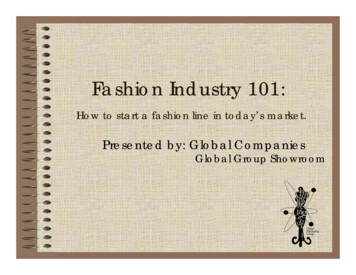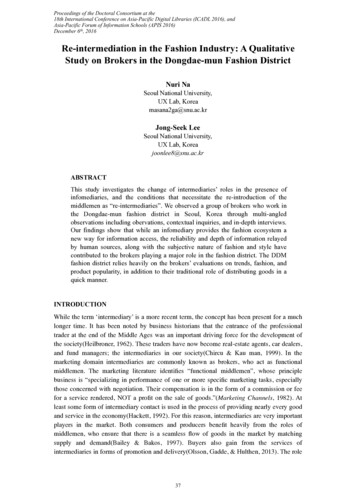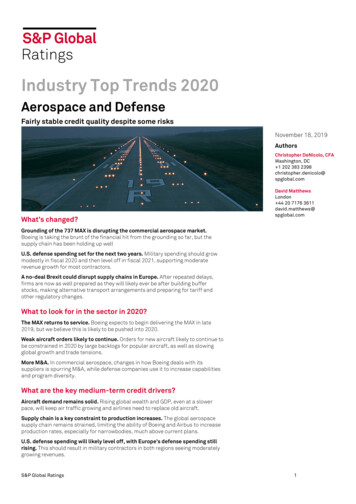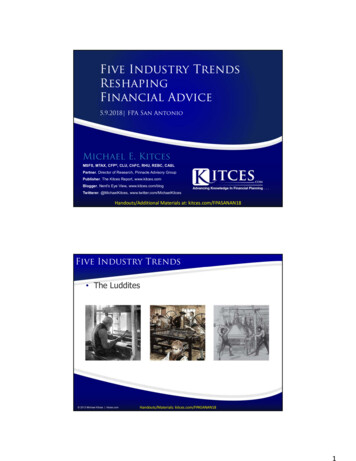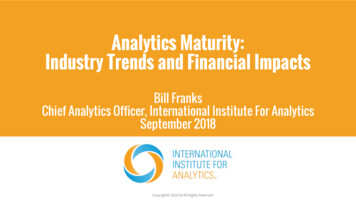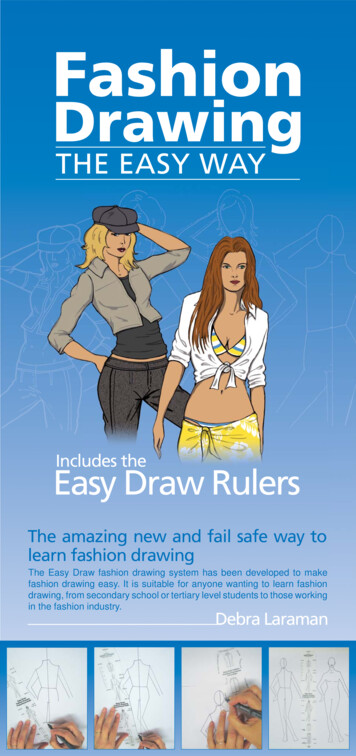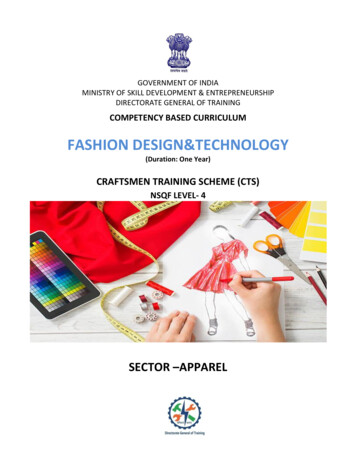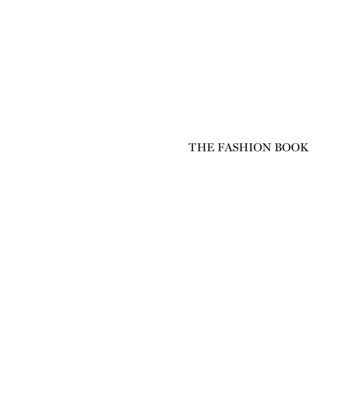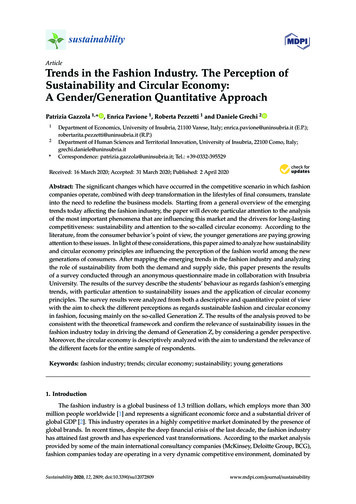
Transcription
sustainabilityArticleTrends in the Fashion Industry. The Perception ofSustainability and Circular Economy:A Gender/Generation Quantitative ApproachPatrizia Gazzola 1, * , Enrica Pavione 1 , Roberta Pezzetti 1 and Daniele Grechi 212*Department of Economics, University of Insubria, 21100 Varese, Italy; enrica.pavione@uninsubria.it (E.P.);robertarita.pezzetti@uninsubria.it (R.P.)Department of Human Sciences and Territorial Innovation, University of Insubria, 22100 Como, Italy;grechi.daniele@uninsubria.itCorrespondence: patrizia.gazzola@uninsubria.it; Tel.: 39-0332-395529 Received: 16 March 2020; Accepted: 31 March 2020; Published: 2 April 2020Abstract: The significant changes which have occurred in the competitive scenario in which fashioncompanies operate, combined with deep transformation in the lifestyles of final consumers, translateinto the need to redefine the business models. Starting from a general overview of the emergingtrends today affecting the fashion industry, the paper will devote particular attention to the analysisof the most important phenomena that are influencing this market and the drivers for long-lastingcompetitiveness: sustainability and attention to the so-called circular economy. According to theliterature, from the consumer behavior’s point of view, the younger generations are paying growingattention to these issues. In light of these considerations, this paper aimed to analyze how sustainabilityand circular economy principles are influencing the perception of the fashion world among the newgenerations of consumers. After mapping the emerging trends in the fashion industry and analyzingthe role of sustainability from both the demand and supply side, this paper presents the resultsof a survey conducted through an anonymous questionnaire made in collaboration with InsubriaUniversity. The results of the survey describe the students’ behaviour as regards fashion’s emergingtrends, with particular attention to sustainability issues and the application of circular economyprinciples. The survey results were analyzed from both a descriptive and quantitative point of viewwith the aim to check the different perceptions as regards sustainable fashion and circular economyin fashion, focusing mainly on the so-called Generation Z. The results of the analysis proved to beconsistent with the theoretical framework and confirm the relevance of sustainability issues in thefashion industry today in driving the demand of Generation Z, by considering a gender perspective.Moreover, the circular economy is descriptively analyzed with the aim to understand the relevance ofthe different facets for the entire sample of respondents.Keywords: fashion industry; trends; circular economy; sustainability; young generations1. IntroductionThe fashion industry is a global business of 1.3 trillion dollars, which employs more than 300million people worldwide [1] and represents a significant economic force and a substantial driver ofglobal GDP [2]. This industry operates in a highly competitive market dominated by the presence ofglobal brands. In recent times, despite the deep financial crisis of the last decade, the fashion industryhas attained fast growth and has experienced vast transformations. According to the market analysisprovided by some of the main international consultancy companies (McKinsey, Deloitte Group, BCG),fashion companies today are operating in a very dynamic competitive environment, dominated bySustainability 2020, 12, 2809; ability
Sustainability 2020, 12, 28092 of 19sudden changes and increasing uncertainty. In a framework dominated by a global increase of lifeage, thanks to progress in the medical sector and other causes, the fashion industry today has theopportunity to serve both young and old generations at the same time; this factor translates into theneed to diversify both business strategies and marketing approaches in order to satisfy the needs ofretired consumers and millennial ones. Uncertainty is driven by geopolitical and economic instability,which have affected the market since the 2008 economic and financial crisis. In 2019 data from theWorld Bank, the International Monetary Fund (IMF) and the Organisation for Economic Co-operationand Development (OECD) forecast a slower growth of the industry in developed markets and a flatgrowth curve in developing countries. The areas most affected by this trend are Europe, Middle East,and Latin America. Due to the increase of economic uncertainty and political instability, the level ofspending for fashion products is declining and, at the same time, the demand for customized andpersonalized fashion, at lower prices, is expected to grow in the future years. In addition to politicalinstability, other problematic events have characterized the last few years: terrorist attacks, naturaldisasters, new epidemics, a combination of factors that are not only devastating for the people theydirectly affect, but also have major consequences for companies and the local communities in whichbusinesses are rooted.Another important change in the competitive scenario is the growing digitalization of theeconomy [3,4]. The fashion industry is more and more interconnected with the digital world. Digitalplatforms and digital marketing strategies are becoming prevalent in the fashion market and manynew brands have emerged with the development of e-commerce, which allows companies to engageconsumers through virtual reality. According to McKinsey [1], a big increase in online sales isexpected in the future with respect to total sales; this trend particularly affects the fashion luxurysegment, which is expected to represent about 13% of the total fashion market in 2020. In recentyears, the fashion industry has also experienced an improvement in relationships with existingclients through marketing and digital promotion, rather than expansion through geographic channelsand store network expansion [5,6]. Most fashion executives see investments in Information andCommunications Technology and the digitalization of the value chain as big opportunities [7,8].Technological investment becomes strategic as the fashion market experiences a growing speed of fastfashion trends. Technology improvement in the production process can provide new opportunitiesfor business, like an acceleration of the life, robust reduction in labor costs, an increase in margins,along with the localization of materials/products (for example, digitalization of inventory), and alsoincrease the sustainability of processes [9,10]. Data provided by the International Labor Organization(ILO) estimate that, within a few decades, more than half of all salaried workers (especially inemerging countries, where labor force in the industry is concentrated), will be displaced by automationtechniques and advanced technologies in the fashion industry, as in other manufacturing based sectorstoo. Agile businesses are usually more stable and dynamic, because the mix between employeeempowerment, development sprints, and the ability to bring solutions rapidly to customers can helpa company become more efficient [11]. Agility requires fashion companies to build flexible supplychains and delivery models able to respond quickly when the environment changes. Disruptions andinstability are situations that are not going to stop. Successful fashion companies, in front of uncertaintyin the competitive scenario, are acting flexibly to ensure that customer needs are met as a primaryobjective. To be dynamic is becoming strategic to survive in the long-term and this implies the need forcompanies to update technologies and to interpret the new trends and to identify how these challengescan be translated into marketing opportunities. As markets and consumer behaviours become moreand more sophisticated every year, a successful company must be an “agile” organization, as theycannot delay decisions. In this highly competitive context, the fashion market is becoming moreand more concentrated: this phenomenon is reflected with the increasing growth, on the one hand,of mergers and acquisitions activities and, on the other hand, of strategic partnership agreements [12].The creation of big conglomerates makes fashion industry brands feel more comfortable and lessuncertain about the challenges of the global market. Alongside changes in the competitive environment
Sustainability 2020, 12, 28093 of 19in which fashion firms operate, consumer behaviour and preferences continue to evolve rapidly;this requires companies to adapt rapidly to emerging trends by focusing on product innovation and bydeveloping new designs for creating new fashion trends [13,14].In particular, the most important changes affecting fashion demand can be summarized as follows:Attention to sustainability and circular economy. Sustainability has recently become an importantnew driver in consumers’ purchasing decisions. Phenomena such as the global population growth,climate change, and land and water scarcity have intensified in recent years and sustainability pressuresrelated both to product and production processes became more relevant in this industry [15,16].The speed of fast fashion, which has emerged in recent years as a new phenomenon with great impactson the industry, amplifies problems, as it is causing high water consumption, high discharge ofhazardous chemicals, an increase in waste, an increase in violations of human rights, together withbigger greenhouse gas emissions. Consumers are expecting transparency more and more across theentire value chain; they want to have more information about both the provenience of goods andthe quality of materials used. Brands are responding to these challenges which have arisen fromthe demand side by trying to be more transparent, in many cases specifying the costs of materials,the mark-up, the costs of labor, transport, duties, and so on. Many cross-industry initiatives havehelped companies to identify more sustainable work practices across the product life cycle and severalbrands have publicly fixed sustainability goals and set standards for imports of fabrics, and they arepromoting initiatives for improving innovations in the materials used for producing fashion items.Online shopping. Statistic ranks available on the Statista.it platform provide the most popularonline shopping categories worldwide, sorted by share of internet users who have purchased productsfrom selected categories online. According to this source, in 2018 57% of global internet users purchasedonline fashion-related products. In recent years, online platforms have continued to grow and havebecome increasingly important in the fashion industry [10]. Many platforms, like Zalando, Amazon,and Myntra, already operate in the fashion industry with their own private label fashion offerings.Online platforms are supposed to grow also in both premium and luxury segments; in this context,fashion companies are trying to improve the customer experience and to increase the quality andvariety of services offered. Increasing the importance of online shopping for mass market and luxuryfashion items has forced fashion brands to collaborate with online platforms [10,16,17]. Most traditionalfashion companies are still skeptical about making collaborations with online giant e-commerce players,because they are scared to lose some control over their brand/company. When brands agree on apartnership with online platforms, there is the need to sign conditions that can benefit both parties.Fashion companies cannot ignore e-commerce anymore and having a partnership with big onlineplayers could be a good way to survive in the market and increase the possibility to sell items in morecountries, strengthening brand awareness at the same time.Fast fashion. Competitive pressures are becoming higher and global demand continues to askfor new collections rapidly. Changing collections about every three weeks has induced consumers toact with a new behavior called “see now—buy now”. Collections and new fashion items are not onlyseasonal brought to market, but increased during the year. The New York Times used the expression“fast fashion” for the first time at the end of 1989, when Zara opened a shop in New York; accordingto this source, a garment produced by Zara would take 15 days to move from the mind of a stylistto the sale of the product itself in a store. Fast fashion is an economic phenomenon that has allowedeveryone to dress following the latest trends [17]. In the last twenty years spending little to dress welland in a different way has become the norm for most people, and this is the reason driving the successof the “fast fashion” trend, that is rapidly becoming present in every market [18]. Customers love tosee different products every week/month in their favorite stores and this has led to an increase in thedemand for new fashion collections over a smaller period of time. This practice has also, on its negativeside, increased pressure and strain on the creativity of designers. At the same time, the productionrhythms imposed on companies following this trend are only sustainable, from a production viewpoint,
Sustainability 2020, 12, 28094 of 19by delocalizing the production in countries where labor costs are low and where it is therefore easy forworkers to be exploited.Personalization. During the last few years, consumers have become more squeamish and moredemanding, they always have high expectations for quality products, customization experiences, andinstant assistance at low prices. Consumers choose fashion items according to their values and theirpersonal style [14]. For this reason, fashion companies have to understand how to offer productsand experiences that customers will perceive as unique. Many fashion companies have answeredto this trend by enlarging their product portfolio and becoming more and more “multistyle brands”.This solution can work well, but sometimes the company has to think about what is the differencethat makes the product of a brand unique for both customers and competitors [14,17]. A wrongchoice can rapidly destroy the brand reputation; this is why brand diversification cannot be the onlyoptimal solution.Use of artificial intelligence. This technological solution help into turn large and diverse datasetsinto enriched information that can be used by companies to improve the entire supply chain, startingfrom design to manufacturing, sales, and advertising [19,20]. Artificial intelligence is largely used tounderstand consumers’ preferences. This helps companies with advertising to reach people who havedemonstrated (for example, through web researches or number of clicks) interest in a special type ofproduct and allows customization of advertisements and personalization of promotions. In this way,potential customers will receive advertisements on products and services that the artificial intelligencealgorithm realizes they were searching, or even complementary ones.Importance of social media and influencers. One of the main trends in developing e-commerceis social commerce—that is, the use of social media, which supports social interactions, andthe contribution of users to assist the sale and purchase of online products and services [21].This phenomenon is at the beginning of its diffusion, all its potential is thus still to be discoveredand analyzed [22]. Social media, such as Facebook, Twitter, Youtube, blog, wiki, and the many othersocial platforms, has proliferated in these last years, allowing businesses to develop a real socialmedia strategy to exploit the enormous potential provided by these channels. Moreover, while inthis period of economic crisis the channel of fashion and traditional apparel is undergoing consistentdeclines, the fashion and online apparel industry is the one that marks the biggest growth with regardto e-commerce sales. A multichannel strategy is no longer seen by companies as a simple means tosell more, but as a useful tool for managing the relationship with the customer, putting at its disposalas many options to follow them in their purchase [23,24]. Multichannel is an increasingly complexphenomenon involving the client at home and in all its movements on different platforms (PC, Tablet,Smartphone, etc.). If the search engines play a particular part in the search for the information, socialnetworks play a strategic role in the post-sales phase. In the social media era, the fashion industry isexperiencing the growing role of influencers, as consumers perceive their lifestyle as more authenticand attractive than traditional advertisements [24,25]. Influencers are perceived as near to the commonpeople because they are not models and are not forced to make a campaign, but wear what theylike and what fits well on their body; they also show their outfits during a common day in commonsituations [25]. This important choice does not take into account only the number of followers, butabove all the fundamental ability to involve their readers (customer engagement) by inviting them toleave comments, opinions, and likes, together with the ease of being able to gain new followers in agiven period. Strong brands that are able to compete successfully in the market today are characterizedby rapid growth, social media influence, and e-commerce focused distribution.Smartphone obsession. According to data from McKinsey and the BoF Fashion Survey of 2018and 2019, mobile data traffic has surpassed desktop traffic and half of the young generation called“millennials” spend more than three hours every day on their personal smartphones [26,27]. This trendforced many fashion companies to create apps for mobile phones, where customers can visit thewebsite adjusted for mobile devices and buy online directly from the smartphone. As consumers every
Sustainability 2020, 12, 28095 of 19year discover the convenience of using their mobile phones for transactions, mobile payments are alsogrowing fast.Less importance attached to ownership. Today, consumers express a desire to take advantage of avariety of items and models, placing increased attention on sustainability and affordability of sources.More and more consumers prefer to rent clothes rather than buy them [28,29].Among the aforementioned changes, the attention to sustainability has undoubtedly been one ofthe most important trends in the last recent years [30]. Closely connected to the theme of sustainabilityis that of circularity: new initiatives based on a circular economy have arisen recently in the globalmarket [31,32]. For example, the Ellen McArthur Foundation has created the “Circular Fibers Initiative”,which has been the beginning of sensibilization to the circular economy for textiles. Their initiativepromotes a transition from the traditional production system to renewable energy sources; the circularmodel builds economic, natural, and social capital based on three principles: minimize waste andpollution, keep products and materials in use (circular system), regenerate natural systems. In the nextsection the new trends of the fashion market in terms of sustainability and circular economy will beexamined, in order to carry out an in-depth analysis on the perception that the new generations haveof these issues in relation to the fashion world. In fact, more and more young consumers are provingto be highly sensible to social and environmental issues and their shopping habits are influenced bythose principles. The fashion market is showing the growing tendency of young consumers to followbrands that show attention to these themes, avoiding others [33].In this framework, the aim of this paper is to offer first an embryonic deepening, susceptible tofurther investigations, on a current topic but currently little investigated by managerial literature.The growing attention that consumers and, in particular, the younger generations, assign to issuesof sustainability and the circular economy, is in fact reflected in the strategies and business modelsof fashion companies, leading to a redefinition of sectorial boundaries. This perspective opens upinteresting research perspectives for management scholars, in particular for marketing and businessstrategy studies.2. The Importance of Sustainability and Circular Economy for the Fashion Market in a GenderGeneration Perspective2.1. Sustainability and Circular EconomySustainability has long been at the center of both scientific and institutional debate. Awareness ofthe need for a change in the sustainable development approach was reaffirmed in the 2030 Agenda.The Agenda is a program of rules, binding the governments of the member countries in respectingpeople and more properly our planet. It gathers 17 objectives, the so-called Sustainable DevelopmentGoals (SDGs) for sustainable development, with 169 goals to be reached by 2030, the deadline withinwhich nations must have met standards for achieving goals [34]. The document in which the 2030agenda is contained takes the name of Transforming Our World and focuses on the three pillars ofsustainable development: economic growth, social inclusion and, environmental protection [35,36].Hák, Janoušková, and Moldan [37] argued that the achievement of sustainability objectives is extremelyimportant for achieving a qualitatively better standard of living. The commitment that each State willhave to implement this goal is extremely important and necessary for the common good of today andtomorrow. Taking into account at the same time, and in a balanced way, the three dimensions that aretraced in the 17 objectives—namely, economic, social, and ecological development—will have to changethe vision and politics of each State [38]. This approach inevitably involves the transition from a linearindustrial system to a circular system that can be enabled by the introduction of a new business model,a product manufacturing cycle with a view to both economic and environmental sustainability [39].Optimization of resource consumption, reduction of energy waste, and reduction of waste are thepossibilities in terms of saving capital and resources, with an impact on the environment both insidethe company and outside. Circularity subverts traditional business models, leading companies to focuson managing resources within markets rather than in production alone. Businesses are driven to focus
Sustainability 2020, 12, 28096 of 19on what is truly valuable for customers [40]. The circular economy, therefore, becomes a paradigm thatbalances economic development with the protection of the environment and resources.The circular economy is very topical and is attracting the attention of both scholars andinstitutions [41,42]. It is a multidisciplinary issue, which literature is addressing from differentpoints of view [43–46].According to the classical definition [47–49], a circular economy is an economy designed to be ableto regenerate itself, using two types of materials: those organic or renewable, designed to be reusedand re-entered at the end of their life cycle in the biosphere, and technical or non-renewable ones,designed to switch cyclically from production to consumption with a minimum loss of quality or value.As an alternative to the linear model of industrial economy, where a resource is used and the deficitdiscarded, the vision of mass consumerism is undermined in the circular economic system throughever new production factors [50,51]. Reuse and recycling act as starting points to avoid major wasteof resources, thus reducing the consequent negative externalities on the external environment [52].Contaminations, pollution, but also conflicts for the control of supplies have characterized the history ofindustrialization. As a consequence, circular economy and the sustainability approach are the basis forgenerating long-lasting benefits by guaranteeing an economic system capable of creating lasting growth,originating income and work for sustenance [53,54]. Sustainability and circular economy impact allsectors of the economy and the fashion world is strongly affected by these new approaches to economicdevelopment. Historically, the fashion industry has been associated with excessive consumerism,extremely high costs, elitism, or guilty pleasures. In recent years, sustainability has been one of themost important trends affecting this industry, as already discussed in the previous paragraph [55].Some data are useful to clarify this point. As previously analyzed, the fashion industry represents abusiness with a global turnover of 1.3 trillion dollars and it employs more than 300 million peopleworldwide. Cotton production represents almost 7% of all jobs in some low-income countries [1].At the same time, the fashion industry uses more than 98 million tons of non-renewable resourcesannually, including oil to produce synthetic fibers, fertilizers for cotton plantations, and chemicalsfor producing, dyeing, and finishing fibers and fabrics. To these, 93 billion cubic meters of water areadded, that contribute to worsening the events of drought, the emission of about 1.2 billion tons of CO2 ,and 500 thousand tons of microplastic fibers poured into the oceans. The social effects are dramatic:employment in the textile sector in underdeveloped countries is often synonymous with low wages,exaggerated working hours, child labor, and slavery conditions. Until the seventies of the last century,in a context in which environmental concerns began to take on importance, fashion firms limitedthemselves to interpreting sustainability in a communicative key, mainly through green marketinginitiatives. It is only from the 1990s that sensitivity towards environmental and social problems hastaken on a new value, not only communicative, but above all anchored to the actual productiveand organizational capacity of companies [56]. The attention to sustainability, including all thoseinterventions of attention to the territory and the community in which the company operates, respectand protection of the environment, enhancement of human resources, safety of working conditions andprotection of health [53], have thus become fundamental drivers for the development of the fashionindustry [15,16,57]. In a broader sense and in a strategic key [58,59], the concept of sustainabilityembraces the search for well-being, for a better quality of life and a sense of responsibility towardsthe community [60]. In an environmental scenario in which the “well-being” variable increasinglybecomes a measure of the wealth that a production system is capable of expressing, the attentionto sustainability goes in the direction of behaviors that do not end in ethical responsibility and incompliance with regulations, but takes on strategic significance [11]. The approach to sustainability, infact, impacts the entire value chain, from the commercial proposal to the relationship with the finalconsumer, up to the management of the end-of-life of a product, within a network gradually moreextensive and complex. Empirical evidence shows that the best-performing companies in terms ofsustainability are those capable of integrating it into governance processes and in rethinking businessmodels, with the aim of seizing the growth opportunities that a sustainable approach brings with
Sustainability 2020, 12, 28097 of 19it [61]. At the same time, compulsive fashion shortens the average life of a dress: the average numberof times a garment is worn before disposal has decreased by 36%. In China this value is about 70% [62].The other novelty concerns the raw material used to produce fashion items in terms of type of fiber:polyester has scaled cotton, becoming the most used fabric since the beginning of the twenty-firstcentury. Garments made of 100% polyester are relatively easy to reconvert into reusable materials [63].In parallel, the use of mixed fibers, cotton-acrylic or cotton-elastane, are very difficult to recycle andtherefore end up swelling the already filled undifferentiated dumps of the world [64]. Very differentis the case of mixtures with natural fiber, for example, cotton and polyester. These mixes, to date,are essentially non-recyclable due to the fact that these two components cannot be separated at lowcost [63]. Some countries, like the Philippines and India, have closed the imports of second-handclothes, in order to protect the local textile industry [64]. On the other side, South Africa governmentallows the import of second-hand clothing only for charitable issues and not for commercial resale [65].Finally, it is important to remember that in 2009 the Copenhagen Fashion Summit launched thefirst sustainability program for fashion companies. In fact, for the first time a report guide has beenpublished on sustainability issues addressed to fashion company CEOs. The CEO’s Agenda waspublished in partnership with famous fashion brands and defined Seven Priority Actions useful tohave a higher sustainability inside the industry: supply chain traceability, saving water, energy andchemicals, workers’ security and respect, sustainable material mix, circular fashion system, better wagesystems, digital revolution. The goal of the CEO’s Fashion Agenda is to encourage fashion leaders todrive their design and product development teams to create durable products, favoring disassembly offibers and realizing recyclable garments. On the other side, retailers are incentivized to increase thepresence of collections of used garments. Leading fashion companies are encouraged on the one handto collaborate with governments to develop better circular systems, and on the other hand to developinnovative technologies that can transform textile waste into high-quality fibers. The fashion industryis still far away from being a circular system, where materials are designed and recycled in order togenerate “additional value” rather than “additional waste”. Many pioneers’ companies a
sustainability Article Trends in the Fashion Industry. The Perception of Sustainability and Circular Economy: A Gender/Generation Quantitative Approach Patrizia Gazzola 1,* , Enrica Pavione 1, Roberta Pezzetti 1 and Daniele Grechi 2 1 Department of Economics, University of Insubria, 21

